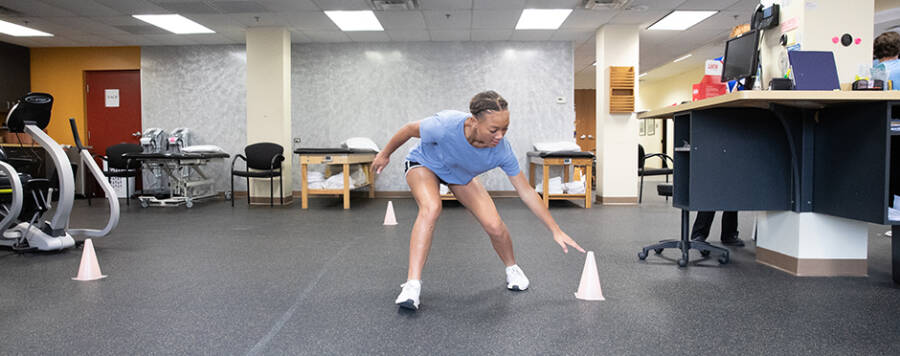So, what do these 6 to 24 months look like? Well, even before surgery, “prehab” has become an important aspect of ACL rehabilitation regarding hitting goals and overall outcomes. There is growing evidence to support that patients who go into surgery with better range of motion (ROM) and strength have improved outcomes earlier after surgery.2 Prehab can begin immediately after injury and last for days, weeks, or sometimes even months until undergoing surgery. Then after surgery, stage one of ACL rehab is all about protecting the graft, normalizing range of motion (ROM), and re-activating the quadriceps muscle. For these goals, the swelling must be controlled, as increased swelling can limit both knee flexion (bending) and extension (straightening) ROM, and limit activation of the quadriceps muscle. We want the involved knee to reach the flexion and extension motion equal to the other leg as soon as possible. The same is true for quadriceps activation; we want as strong of a contraction as we can as quickly as possible, but especially to be able to lift the leg in the air without any knee bend, which will also help normalize walking mechanics.
To reach the second stage of rehab, patients need to have full ROM, be walking without crutches with a normalized gait, and have the strength to stand on the injured leg, The goal of the second stage of rehab is functional strength, strength, strength! Rehab is focused on improving quadriceps and hamstring strength to within 90% of the strength of the uninjured leg.3 While working on quadriceps and hamstring strength, you will also work on proximal hip strength and your form with functional movements such as squats, jumping, and landing.
When patients reach 90% strength in the injured leg compared to the uninjured leg, demonstrate good form with single leg squats, double and single leg jumps, and are cleared by physician from a time-based perspective, it is time to begin return to sports activities. This is when rehab is focused on quick changes in direction and cognitive tasks to re-train both the muscles in the affected leg and the brain! Athletes may be allowed to do some non-contact sports activities in this phase as well.
When athletes demonstrate good form with functional movement patterns while distracted and have confidence to return to sport, they will be cleared for a full-contact return without limitation. Athletico’s ACL 3P program offers a cluster of subjective and objective criteria in their ACL 3P return to play report card to confirm these good movement patterns and confidence and support surgeon’s clearance and readiness to return to play with minimal risk of re-injury. 38.2% of those who failed return to play criteria suffered subsequent injuries compared to 5.6% of those who passed.4 Again, each rehab is different, but this can occur anywhere between 6 to 24 months, with the overwhelming majority occurring between 9- and 12-months post ACL reconstruction. In athletes who returned to play earlier than 9 months post-op, the rate of subsequent ACL injury was approximately 7x higher.5
Let Us Help You Get Back in the Game
Prompt rehabilitation and objective return to play testing are essential to minimizing the recovery period, maximizing your outcome post ACL reconstruction, and minimizing your risk of subsequent injury. If you are about to have or have recently had ACL reconstruction surgery, please contact your local Athletico Physical Therapy clinic to get you back in the game!
Find an ACL Specialist Near You
The Athletico blog is an educational resource written by Athletico employees. Athletico bloggers are licensed professionals who abide by the code of ethics outlined by their respective professional associations. The content published in this blog is for informational purposes only, does not constitute medical advice and should not be relied on for making personal health decisions.
References:
1. Centers for Disease Control and Prevention. (2010, July 13). CDC – Injury – ICRCs – CE001495. Centers for Disease Control and Prevention.
2. Carter, H.M., Littlewood, C., Webster, K.E. et al. The effectiveness of preoperative rehabilitation programmes on postoperative outcomes following anterior cruciate ligament (ACL) reconstruction: a systematic review. BMC Musculoskelet Disord. 21, 647 (2020). https://doi.org/10.1186/s12891-020-03676-6
3. Sue D. Barber-Westin, Frank R. Noyes. Factors Used to Determine Return to Unrestricted Sports Activities After Anterior Cruciate Ligament Reconstruction. Arthroscopy: The Journal of Arthroscopic & Related Surgery, Volume 27, Issue 12, 2011. Pages 1697-1705. https://doi.org/10.1016/j.arthro.2011.09.009.
4. Grindem H, Snyder-Mackler L, Moksnes H, Engebretsen L, Risberg MA. Simple decision rules can reduce reinjury risk by 84% after ACL reconstruction: the Delaware-Oslo ACL cohort study. British Journal of Sports Medicine 2016;50:804–808
5. Beischer S, Gustavvson L, Senorski EH, Karlsson J, Thomee C, Samuelsson K, Thomee R. Young athletes who return to sport before 9 months after anterior cruciate ligament reconstruction have a rate of new injury 7 times that of those who delay return. Journal of Orthopedic and Sports Physical Therapy 2020; 50(2): 83-90
Kevin was a physical therapist at Athletico Physical Therapy at the time of this blog.

 width="900"
height="356"
>
width="900"
height="356"
>
